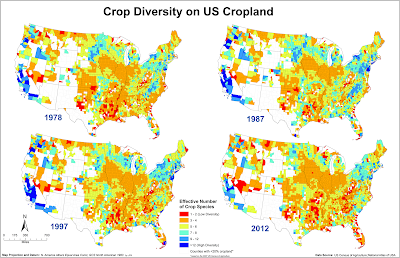From 1978 to 2012 the amount of crop diversity grown by U.S. farmers has declined, says a county-level study by researchers at Kansas State University, North Dakota State University and the U.S. Department of Agriculture published in PLOS One, Mary Lou Peter reports for Kansas State University. Less crop diversity "could have implications for how farms fare as changes to the climate evolve."
"Croplands comprise about 408 million acres (165 million hectares) or 22 percent of the total land base in the lower 48 states, so changes in crop species diversity could have a substantial impact not only on agroecosystem function but also the function of surrounding natural and urban areas," Peter writes. "Because croplands are typically replanted annually, theoretically crop species diversity can change fairly rapidly. There is the potential for swift positive change, unlike in natural ecosystems."
Lead author Jonathan Aguilar told Peter, “At the very simplistic level crop diversity is a measure of how many crops in an area could possibly work together to resist, address and adjust to potential widespread crop failures, including natural problems such as pests and diseases, weed pressures, droughts and flood events. This could also be viewed as a way to spread potential risks to a producer. Just like in the natural landscape, areas with high diversity tend to be more resilient to external pressures than are areas with low diversity. In other words, diversity provides stability in an area to assure food sustainability.”
The most crop diversity was seen in the Fruitful Rim (parts of Washington, Oregon, Idaho, California, Arizona,
Texas, Florida, Georgia and South Carolina) and the Northern Crescent
(states along the northeast border from part of Minnesota east through
Wisconsin, Michigan through to Maine and south to New Jersey and
Pennsylvania), Peter writes. "The Mississippi Portal Region, which includes parts of Louisiana,
Mississippi, Kentucky and Arkansas, had significantly higher crop
diversity in 2012 than in 1978."
The Heartland Resource Region (Illinois, Iowa, Indiana and parts of Ohio, Missouri, Minnesota, South Dakota, Nebraska and Kentucky), "which is home to 22 percent of U.S. farms and represents the highest value, 23 percent, of U.S. production, had the lowest crop diversity." (Read more)

No comments:
Post a Comment